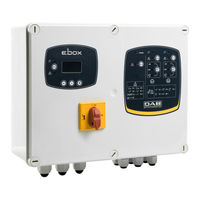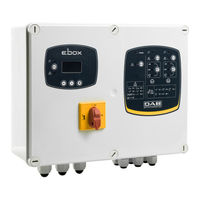DAB E.Box Basic Manuels
Manuels et Guides d'utilisation pour DAB E.Box Basic. Nous avons 2 DAB E.Box Basic manuels disponible en téléchargement PDF gratuit: Instructions Pour L'installation Et La Maintenance
DAB E.Box Basic Instructions Pour L'installation Et La Maintenance (880 pages)
Table des Matières
-
Italiano
3-
Legenda8
-
Pressostati22
-
Pressostati44
-
Menù47
-
SN: Serial49
-
Menù Utente49
-
LA: Lingua50
-
English
61-
General66
-
Key66
-
Warnings66
-
Installation67
-
Protections67
-
Front Panel73
-
Pressure Sensor102
-
System Operation102
-
Menus105
-
Status Line105
-
SN: Serial107
-
User Menu107
-
LA: Language108
-
Pressure Sensor)108
-
Setpoint Menu108
-
-
Filling Function112
-
-
-
Français
119-
Avertissements124
-
Généralités124
-
Légende124
-
Responsabilités124
-
Installation125
-
Protections125
-
Panneau Avant131
-
Vase D'expansion133
-
Pressostats138
-
-
Démarrage147
-
-
Vase D'expansion155
-
Pressostats160
-
Accès aux Menus163
-
Barre D'état163
-
Menu163
-
Menu Utilisateur165
-
SN: Serial165
-
LA : Langue166
-
AL : Anti-Fuite168
-
Alarme Erreur172
-
Erreur Interne172
-
Tension D'entrée172
-
NI : Alarmes ni174
-
RI : Alarmes RI174
-
W1 : Trimmer SP175
-
W2 : Trimmer DP175
-
-
Deutsch
177-
Haftung182
-
Hinweise182
-
Legende182
-
Allgemeines183
-
Installation183
-
Frontpaneel189
-
Ausdehnungsgefäß191
-
Druckwächter196
-
Drucksensor197
-
Füllfunktion197
-
Steuereingänge198
-
Steuereingänge206
-
Ausdehnungsgefäß214
-
Druckwächter218
-
Drucksensor219
-
Menü221
-
Statuszeile221
-
Benutzer-Menü223
-
SN: Serial223
-
LA: Sprache224
-
Mit Drucksensor)224
-
Sollwert-Menü224
-
MS: Maßsystem225
-
ET: Wechselmodus226
-
Alarm DIP-Switch229
-
Pumpe Abgehängt229
-
Eingangsspannung230
-
Fehler-Alarm230
-
Interner Fehler230
-
Spannungsfehler230
-
NI: Alarme ni232
-
RI: Alarme RI232
-
W1: Trimmer SP233
-
W2: Trimmer DP233
-
W3: Trimmer Imax233
-
Publicité
DAB E.Box Basic Instructions Pour L'installation Et La Maintenance (62 pages)
Marque: DAB
|
Catégorie: Panneaux de contrôle
|
Taille: 3.12 MB
Table des Matières
-
Menu Écran51
Publicité

